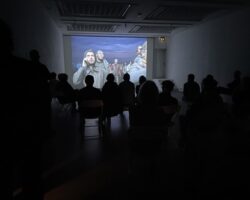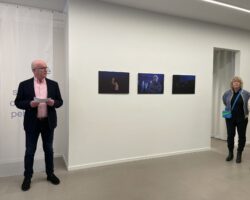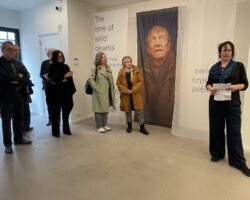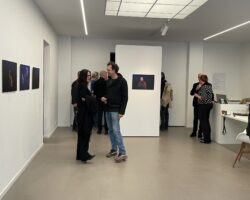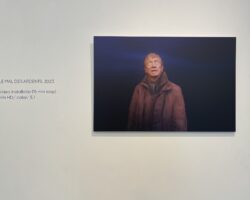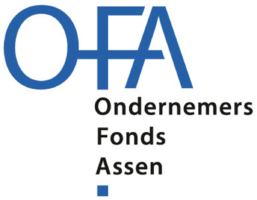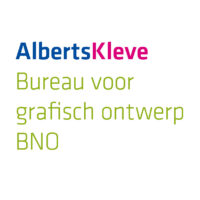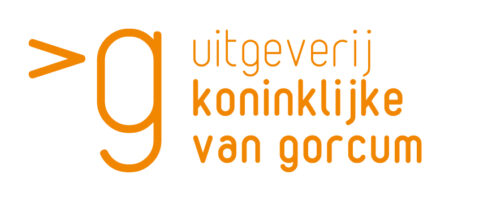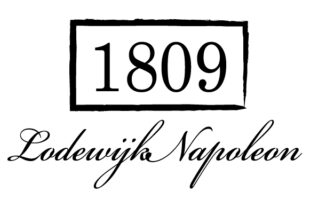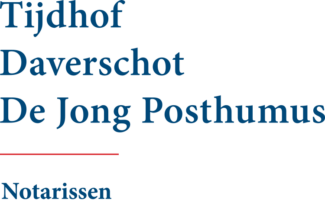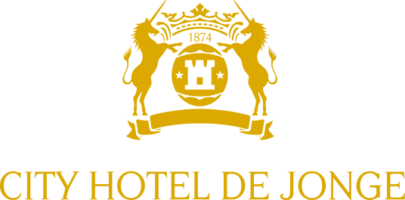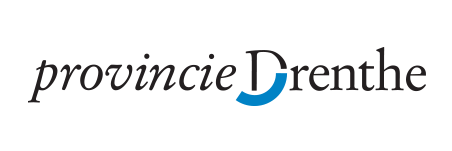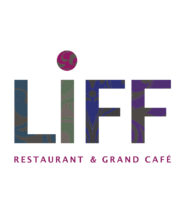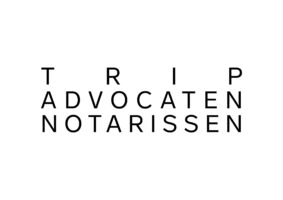Openingswoord Le Mal des Ardents
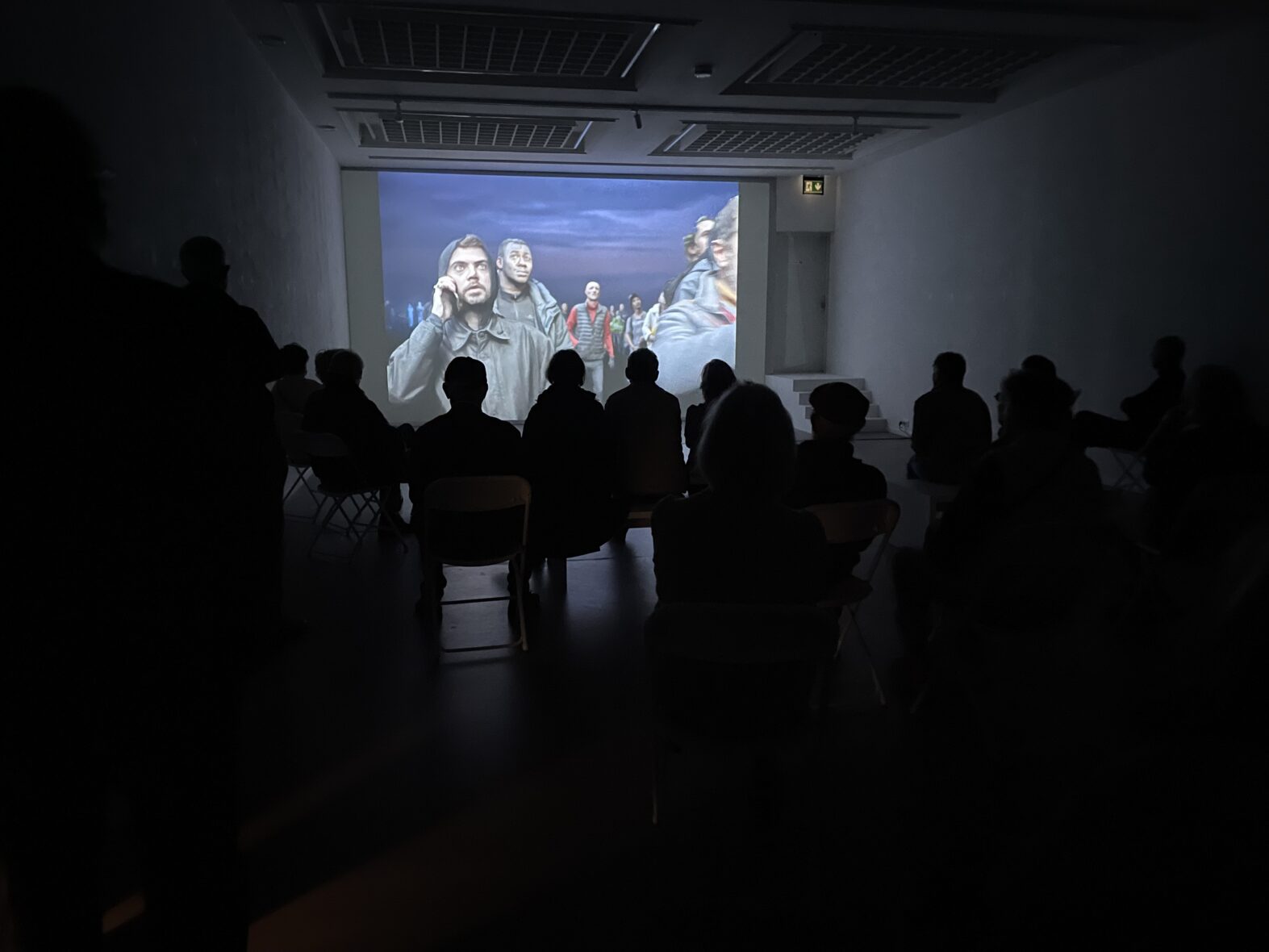
Op 23 maart j.l. opende artistiek leider Regina Broersma de tentoonstelling Le Mal des Ardents van Alice Byrgo. Dat deed ze met de volgende woorden:
“Het valt me op hoezeer ons leven draait om verhalen.
De verhalen die we onszelf vertellen over wie we zijn.
Over de wereld om ons heen.
Hoe we gebeurtenissen kleuren met betekenis.
Hoe een blik, een woord, een stilte
al genoeg kunnen zijn om een hele vertelling
in ons hoofd te laten ontstaan.
Toen ik dit werk voor het eerst zag, bleef het hangen.
De sfeer. De beklemming.
De manier waarop mensen kijken en wachten.
Gevangen in een moment waarvan we niet weten
wat eraan voorafging,
of wat erna zal komen.
Het is die onbestemde spanning
die Alice Brygo zo goed weet te vangen.
Ze beweegt zich op het snijvlak van documentaire en fictie
en onderzoekt hoe groepsdynamiek en massagedrag ontstaan.
Haar beelden lijken haast mythisch,
maar voelen tegelijk pijnlijk herkenbaar.
Le Mal des Ardents laat zien
hoe realiteit en verbeelding in elkaar grijpen.
Hoe de wereld niet alleen iets is wat ís,
maar ook iets wat we erváren.
Door de lens van ons eigen denken,
onze angsten, verlangens en overtuigingen.
“There is another world, but it is in this one.”
Die zin hangt al jaren op mijn koelkast.
Een herinnering dat er binnen dezelfde wereld
altijd meerdere werkelijkheden naast elkaar bestaan.
Tegelijk verwijst het naar de kracht van verbeelding.
In kunst, in dromen, in herinneringen.
Zelfs in angst schuilt diezelfde kracht:
het vermogen om iets anders te zien
dan wat er op het eerste gezicht is.
De quote wordt vaak toegeschreven aan W.B. Yeats,
maar is oorspronkelijk van de Franse surrealist Paul Éluard.
Misschien is dat juist hier wel passend:
hoe betekenissen verschuiven,
hoe verhalen zichzelf herschrijven.
Le Mal des Ardents beweegt zich op datzelfde grensvlak.
Het laat zien hoe de werkelijkheid vervormt.
Hoe massagedrag zich verspreidt.
Hoe de grens tussen feit en fictie steeds verder vervaagt.
We openen vandaag een tentoonstelling met slechts één werk.
Misschien voelt dat als weinig,
in een wereld waarin we gewend zijn overspoeld te worden met beelden.
Maar soms is één werk genoeg.
Eén werk kan een wereld op zich zijn.
Sommige werken hebben geen gezelschap nodig.
Ze eisen hun eigen ruimte op.
Le Mal des Ardents is zo’n werk.
Niet om vluchtig te bekijken,
maar om in onder te dompelen.
Om je in te verliezen.
Alice Brygo vangt iets wezenlijks in deze videoinstallatie:
het gevoel van een tijd waarin onzekerheid de boventoon voert
en collectieve emoties zich razendsnel verspreiden.
We herkennen die momenten misschien.
In hoe we reageren op crisis. Op nieuws. Op elkaar.
Daarom wil ik dit werk hier laten zien.
Omdat het confronteert.
Omdat het vragen oproept.
Omdat het niet eenduidig is,
maar juist ruimte laat voor interpretatie.
Neem de tijd om te kijken.
Te voelen.
Te dwalen.
Laat het werk op je inwerken.
Zonder haast. Zonder verwachting.
Met deze film opent Brygo niet alleen
een kritische blik op de wereld om ons heen,
maar laat ze ons ook voelen hoe we ons daartoe verhouden.
Want wat we zien, is nooit neutraal.
Het is verbonden met wie we zijn.
Met wat we vrezen.
Met wat we verlangen.
En misschien — zoals Yeats wél schreef: “The world is full of magic things,
patiently waiting for our senses to grow sharper.”
En zo nodigt kunst ons uit
om niet alleen scherper te zien,
maar ook anders te kijken.
Met open zintuigen.
Met aandacht voor wat zich
tussen de beelden en betekenissen beweegt.
Laat het prachtige werk van Alice Brygo
niet alleen je blik scherpen,
maar ook iets in jezelf in beweging brengen.”
Regina Broersma
Artistiek leider CAMPIS
On March 23rd 2025, artistic director Regina Broersma opened the exhibition Le Mal des Ardents by Alice Byrgo. This was her opening speech:
“I’m struck by how much our lives revolve around stories. The stories we tell ourselves about who we are,
and about the world around us.
How we colour events with meaning.
How a glance, a word, a silence
can be enough to spark an entire narrative
in our minds.
When I first saw this work, it stayed with me.
The atmosphere. The tension.
The way people look, and wait.
Caught in a moment whose beginning we don’t know,
and whose end we cannot see.
It is that elusive tension
that Alice Brygo captures so precisely.
She moves along the edges of documentary and fiction,
exploring how group dynamics and collective behaviour emerge.
Her images feel almost mythical,
and yet painfully familiar.
Le Mal des Ardents shows
how reality and imagination intertwine.
How the world is not only something that is,
but something we experience.
Through the lens of our own thoughts,
our fears, desires, and beliefs.
“There is another world, but it is in this one.”
That quote has been on my fridge for years.
A reminder that even within the same world,
multiple layers of reality can exist side by side.
It also speaks to the power of imagination,
in art, in dreams, in memory.
Even fear contains that same power:
the ability to see something other
than what appears at first glance.
The quote is often attributed to W. B. Yeats,
but originally comes from the French surrealist Paul Éluard.
And perhaps that is fitting here,
where meanings shift,
and stories rewrite themselves.
Le Mal des Ardents moves within that same threshold.
It shows how reality warps.
How mass behaviour spreads.
How the line between fact and fiction begins to blur.
Today, we open an exhibition with just a single work.
That may seem like very little,
in a world where we are used to being flooded with images.
But sometimes, one work is enough.
One work can hold an entire world.
Some pieces don’t need company.
They claim their own space.
Le Mal des Ardents is such a work.
Not to be watched in passing,
but to immerse yourself in.
To get lost in.
In this video installation, Alice Brygo captures something essential.
A sense of living in a time where uncertainty prevails,
and collective emotions ripple at high speed.
We might recognise that feeling.
In how we respond to crisis.
To the news.
To each other.
That is why I wanted to present this work here.
Because it confronts us.
Because it raises questions.
Because it is not conclusive,
but instead leaves room for interpretation.
Take time to watch.
To feel.
To drift.
Let the work settle into you.
Without haste. Without expectation.
With this film, Brygo not only offers
a critical view of the world around us.
She also lets us feel
how we relate to it.
Because what we see is never neutral.
It is connected to who we are.
To what we fear.
To what we long for.
And perhaps — as Yeats did write:
“The world is full of magic things,
patiently waiting for our senses to grow sharper.”
Art invites us not only to see more clearly,
but also to see differently.
With open senses.
With attention to what moves
between images and meanings.
Let the powerful work of Alice Brygo
not only sharpen your gaze,
but stir something within you.”
Regina Broersma
Artistic Director CAMPIS
